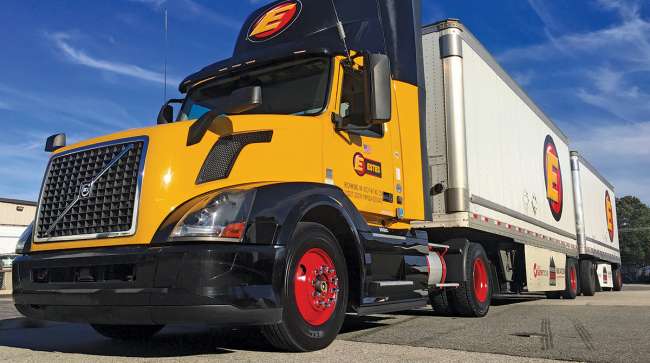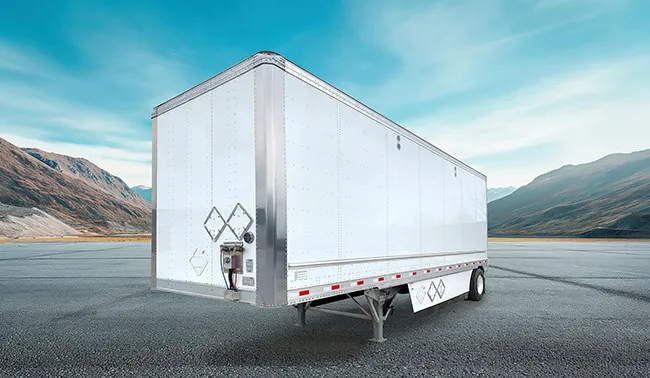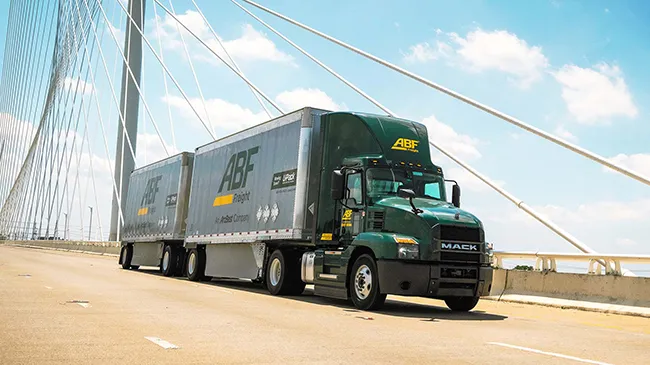Contributing Writer
Pup Trailers Can Help Fleets Improve Efficiency, Lower Costs

[Stay on top of transportation news: Get TTNews in your inbox.]
Trucks pulling two 28-foot trailers, or “pups,” have become common in the less-than-truckload segment as large fleets utilize these vehicle combinations to increase flexibility in their delivery networks, improve freight efficiency and reduce their operating costs.
While 28-foot doubles trailers don’t add much cargo space compared with a standard single 53-foot trailer, they can offer operational advantages, especially in cases where trailers “cube out” long before they reach their maximum weight.
Twin trailers can be broken up quickly or dropped and hooked. A single tractor pulling two trailers is more efficient than two tractors pulling two trailers. Fleets can buy fewer tractors and use fewer drivers.
“Just from the basic math, if you’re driving the same miles with fewer tractors, your overall maintenance budget should be somewhat less,” said Rick Mihelic, director of emerging technologies for the North American Council for Freight Efficiency.
Using multiple trailers often makes sense for carriers hauling freight generated by e-commerce, he said, adding that package density in the industry has decreased significantly in recent years.

Buckley
Tractors legally can pull two 28-foot trailers throughout the interstate highway system if they and the tractor weigh no more than a combined 80,000 pounds. Some states, especially in the West, allow longer combination vehicles, including triple trailer combinations with a tractor pulling three pup trailers, and “Rocky Mountain doubles,” which involve one trailer up to 53 feet long and a pup trailer. The use of longer combination vehicles also has been expanding in Canada.
Scott Buckley, senior sales director for national accounts at Stoughton Trailers, said his company saw a reduction in the number of doubles trailers sold during the COVID-19 pandemic. However, the market has begun to rebound in the last year or so.
“This business model seems to be growing with LTL companies growing over the last four to five years,” he said.
The biggest portion is being used by the largest carriers, Buckley said.

Stoughton said it saw a reduction in the number of doubles during the pandemic, although the market has begun to rebound. (Stoughton Trailers)
Estes Express Lines uses triples in those areas where it can, such as on the West Coast, said Billy Hupp, Estes vice chairman and corporate executive vice president. More consistent regulations would make things easier.
“We’ll pull three drivers with two sets each to a certain point, then we’ll make them triples to go across two states,” he said. “Then we have to stop and unhook them again.
Buckley stressed that consistency among the states would certainly make it easier for fleets to plan and easier to get a benefit from some of the efficiencies that triples provide.
Estes ranks No. 11 on the Transport Topics Top 100 list of the largest for-hire carriers in North America and No. 4 among LTL players.
Pup Trailer Benefits
Matt Godfrey, president of ABF Freight, said the majority of the company’s trailer equipment is 28-foot pup trailers — 18,000 pups in all. The company operates the bulk of its over-the-road linehaul network with sets of pups.
“We’re pretty much using pups in our linehaul network at every opportunity,” he said.

The bulk of ABF Freight’s over-the-road linehaul network is done with sets of pups. (ABF Freight)
ABF Freight ranks No. 7 on the TT list of the largest LTL carriers.
Godfrey said hauling two pups with a combined 56 feet of length gives the company more space and flexibility than one 53-foot van. The company can reduce dispatches and improve efficiency and sustainability. A driver can leave Cincinnati hauling trailers bound for Dayton and Chicago distribution centers. Instead of separate dispatches, they both can go to Dayton, where one trailer is dropped off and replaced with another Chicago-bound one. Pups also provide flexibility in urban environments and are easier to operate in residential neighborhoods. With the increased flexibility and higher load average, the company comes out ahead in fuel consumption.

Godfrey
“If we had to run half-empty 53s because that’s all we had in our network, we’d be creating extra dispatches, extra road miles, whereas the pups give us the flexibility not to do that,” Godfrey said.
Estes’ Hupp said the majority of his fleet’s trailers are pups. They reduce freight handling and make it easier to meet delivery schedules. Estes requires multiple strategies because it offers next-day, two-day and longer-term services.
“We use it as a tool,” he said. “There’s no exact science to it, but generally speaking it gives us more flexibility.”
Pup trailers do, however, present some unique hurdles, Hupp said. They require more coordination and certified drivers with special skills. They require two doors at a terminal and two jockeys instead of one if the pups are taken to the same location. But the greater planning flexibility makes them a winning alternative.

Hupp
“Cubing is an art, not a science,” he said. “Days that are light, you might have to swing that trailer through another terminal on the way and finish cubing it out depending on what their needs were. It’s a jigsaw puzzle every night, and every night the pieces are different. In a night, there’s always a few left over that didn’t fit the puzzle. They have to be prioritized the next night.”
Even though multiple-trailer vehicles can be more demanding for drivers, NACFE’s Mihelic said they nonetheless offer a safety premium by reducing the miles driven per vehicle.
Furthermore, sensors and other technologies will continue to make the setups safer and will protect against blind spot accidents. Automated tugs will move the trailer once it’s inside the fence, just as railroad companies have been doing for years. As automation technology improves, so will the safety of longer combination vehicles.
“If we can buy into letting a Tesla drive itself on the highway, and we can buy into an Aurora tractor running in Texas pulling a 53-foot trailer, it seems that technology jump should start being applicable to doubles and triples, and making those safer as well,” he said.
Twin Trailer Innovation
Hupp said pups are as durable as other trailers. Estes expects them to last about 20 years.
Usually, problems occur with floors or a worn coupling device. Replacing the device is a major repair, so at that point Estes usually replaces the trailer.
Brian Hanlon, product manager at Wabash, said there’s no inherent additional wear and tear on a double trailer versus a single.
While two 28-foot pups are 56 feet long versus a 53-foot trailer, some space is lost at the door, Hupp said. However, the company has taken steps to maximize the trailers’ efficiency. It retrofits the insides by putting captive beams in the ceiling that can be lowered to allow double stacking without placing pieces of freight on top of each other. Webb Walls allow for improved strapping.

Palmer
Estes is making other efforts to improve its pup trailer offerings. Mike Palmer, vice president of fleet services, said the company is using a new Ridge Corp. composite trailer door that is 100 pounds lighter.
It also has been working with trailer manufacturer Strick to develop two of Strick’s Elevator concept trailers. A belly between the wheels adds more space and allows loaders to triple stack using a built-in elevator.
Palmer said the design has promise. Strick and Estes together have been working through the challenges of the increased weight and the elevator functions.
“If this works, you’d pick up some cube, and that’s what everybody’s after,” he said.
Want more news? Listen to today's daily briefing below or go here for more info:

